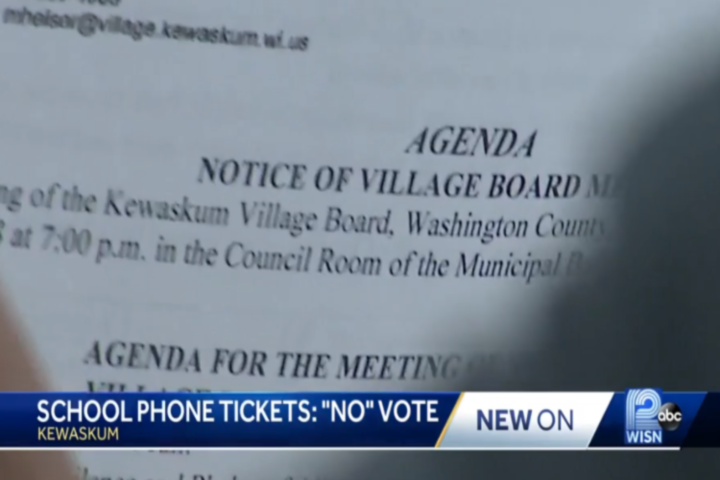Officials at Kewaskum High School in Wisconsin’s Washington County wanted a new three strike policy for students who violate the school’s cell phone policy, including fines for a third-offense, but village officials shot down the plan.


Officials at Kewaskum High School in Wisconsin’s Washington County wanted a new three strike policy for students who violate the school’s cell phone policy, including fines for a third-offense, but village officials shot down the plan.
Vice Principal Mark Bingham told the Milwaukee Journal Sentinel cell phones have become the district’s top discipline problem, and officials requested a village ordinance to ticket and fine students for using the devices in class.
“We want to try to eliminate those distractions and truly utilize that classroom time for learning,” Bingham said. “Obviously … our hope is that we don’t get to that situation where we have to involve law enforcement.”
The Journal Sentinel highlighted a vast differences in school cell phone policies across the state, from schools that ban them outright, to others that allow use in classrooms for educational projects. Some schools also allow students to keep their phones on them during the school day, but only allow them to use the devices during lunch and breaks.
Liz Kolb, a University of Michigan professor who studies technology in the classroom, said schools have generally shifted to more lenient policies as smartphones have become more popular.
A 2015 Pew Research Center report claims about 88 percent of 13- to 17-year-olds have access to a cell phone or smartphone, and nearly a quarter of them are online “almost constantly,” the Journal Sentinel reports.
“Plenty of studies show that it can be very distracting and can reduce the cognitive capacity in the classroom – students can be distracted just knowing they may be getting a text,” Kolb said.
On the other hand, “there is a lot of potential for cellphones to … extend learning to students’ real lives, especially for high-needs, low-income students for whom the family cellphone may be the only device they have to navigate the outside world and digital resources.”
The Kewaskum Village Board discussed the school district’s proposal, which “crashed and burned badly,” village board president Kevin Scheunemann told WISN. School officials did not attend the meeting to discuss the proposal, not a single person spoke in favor of it, and the board ultimately voted 7-0 to kill the idea.
The proposed ordinance would have confiscated phones from students the first time a student was caught with it at school, and a second offence would require a parent to collect the device. A third offense would have come with a $124 ticket, police chief Tom Bishop told WISN.
“If the school district wants to do something like this in the future, they have to at least be here to defend the proposal,” Scheunemann said after the vote. “I think that’s what really hurt them here tonight.”
While the proposed Kewaskum ordinance wasn’t successful, several “pedagogical” schools have improved learning by dialing down the technology to help students focus on what really matters.
Researchers with the Institute for Advanced Studies in Culture noted the impact of low- or no-tech policies in “The Content of Their Character,” a summary of character education in a variety of schools.
The Waldorf, Montessori, Friends, Democratic, and International Baccalaureate high schools studied, among the most sought after in the U.S., “had some limits on the use of technology in the classroom – for example, minimal projector use, no Smart Boards, and no cell phones in the school,” education researcher David Sikkink wrote.
The “pedagogical” schools, Sikkink said, were defined by a commitment to particular modes of learning that limited technology based on the principles of the pedagogy.
Teachers in other schools, including ninth-grade government teacher Ken Halla, have successfully integrated mobile devices into classroom lessons. Halla explained on the NEA union blog why he thinks smartphones can be an education booster with the right kind of supervision.
For further reading on CultureFeed